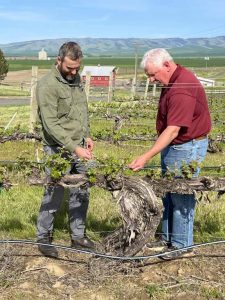by Jay DeWitt, Managing Partner and Vigneron

My 86 year old father likes to say, “farming is a series of compromises.” It is one of those nuggets of wisdom that takes years to understand. Each vintage begins with the promise of perfection. We are ready. The vineyard has been pruned precisely. We have the knowledge, the machines, a dedicated crew, and positive energy. Inevitably, perfection is lost, replaced by compromise.
In some years a harsh winter ruins the vintage before the grapes have a chance to grow. 2022 was close. The temperature at Birch Creek vineyard bottomed out at 0°F on new years eve. Dirk and I brought in the new year struggling to get our 3 wind machines started. We finally succeeded shortly after midnight. The wind machines kept the coldest air from setting around the buds, and in this case it was just enough to get us through without much damage. Three miles north of us the low temperature was -12°F and the more sensitive varieties were lost for the year.
Spring was unusually cold and wet. NOAA tracks heat unit accumulation at various sites. Thru July 1, 2022 at the Walla Walla airport, the heat unit accumulation for 2022 was the lowest on record, tying 1955. What a contrast to last year, which was one of the hottest on record. Accumulated rainfall was nearly a record, and a whopping 9.5 inches above the same date for 2021 which was the driest on record. One might make the sardonic observation that the weather over the last two years has been average, if combined. Farming is so much fun!
Ours is an arid climate, so too much rain early in the year is not a problem for us, it just means delaying our irrigation. Lack of heat is another matter. Fortunately, July was warm and we have largely caught up on heat units. One of the advantages of being small is that we can monitor the grapes closely for the peak of quality; the point where flavor development, acid balance, and tannin resolution are optimum. In a cold year the grapes don’t always ripen fully, so that particular advantage is lost. In those years (2011 is the perfect example), we rely on our winemaking skills to differentiate our wines.
So, you might ask if perfection is unattainable for 2022. Absolutely not! This year’s problems are all solvable, and we are 70% of the way there. Stay tuned!